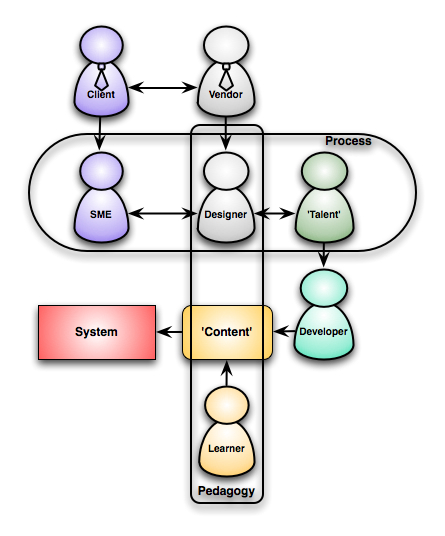Two days ago I attended the 3D Teaching, Learning, & Collaboration conference, organized by Tony O’Driscoll. I’ve previously posted my thoughts on virtual worlds, but I had a wee bit of a revelation that I want to get clear in my head, and it ties into several things that went on at the conference.
First, let me say that the day of the conference I got to attend was great, with lots of the really involved folks there, and every evidence (including the tweet stream) that the second day was every bit as good. Tony talked about his new book with Karl Kapp, Chuck Hamilton spoke on lessons learned through IBM’s invovlement in Virtual Worlds, Koreen Olbrish chaired a panel with a number of great case studies, to name just a few of the great opportunities.
Chuck listed 10 ‘affordances‘ of virtual worlds, expanding a list Tony had previously started. There was some debate about whether affordance is a good term, since not everyone knows it, but I maintain that for people who need it, it’s the right term and that we can use some term like ‘inherent capability’ for those who don’t. I had some quibbles with Chuck’s list, as it seemed that several confounded some issues, and I hope to talk with him more about it.
Tony also presented, in particular, some principles about designing learning for virtual worlds (see slide 17 here). Interestingly, they aren’t specific to virtual worlds, and mirror the principles for designing engaging learning experiences that come from the alignment of educational practice and engaging experiences I talk about in my book. Glad to see folks honing in on principles for creating meaningful virtual world experiences!
The revelation for me, however, was linking the social informal learning with virtual worlds. Virtual worlds can be used for both formal and informal learning, they’re platforms for social action. I’ve had the formal and informal separated in my mind, but needn’t. I’ve been quite active in social learning to meet informal learning needs with my togetherLearn colleagues, but have always written off virtual worlds as still having too much technical and learning overhead to be worth it unless you have a long-term intention where those overheads get amortized.
What’s clear is that, increasingly, organizations are creating and leveraging those long term relationships. ProtonMedia even announced integration of both Sharepoint and their own social media system with their virtual world platform, so either can be accessed in world or from the desktop. There were a suite of examples across both formal and informal learning where organizations were seeing real, measurable, value.
The underlying opportunities of virtual presence are clear, it’s just not been clear that it’s significantly better than a non-immersive social networking system. Certainly if what your people need to formally learn, or informally network on is inherently 3D, but the contextualization is having some benefits.
Some issues remain. At lunch I was talking to some gents who have a system that streams your face via webcam onto your avatar, so your real expressions are represented. That’s counter to some of the possibilities I see to represent yourself in virtual worlds as you prefer to be seen, not as how nature commands, but there are some trust issues (and parental safety concerns as well).
Still, as technical barriers are surpassed, and audiences become more familiar with and comfortable in virtual worlds, the segue between formal and social networking can be accomplished in world making a virtual business office increasingly viable. It may be time to dust off my avatar and get traveling.
 The point is, we have to quit looking at it as design, development, etc; and view it not just as a process, but as a system. A system with lots of inputs, processes, and places to go wrong. I tried to capture a stereotypical system in this picture, with lots of caveats: clients or vendors may be internal or external, there may be more than one talent, etc, it really is a simplified stereotype, with all the negative connotations that entails.
The point is, we have to quit looking at it as design, development, etc; and view it not just as a process, but as a system. A system with lots of inputs, processes, and places to go wrong. I tried to capture a stereotypical system in this picture, with lots of caveats: clients or vendors may be internal or external, there may be more than one talent, etc, it really is a simplified stereotype, with all the negative connotations that entails.